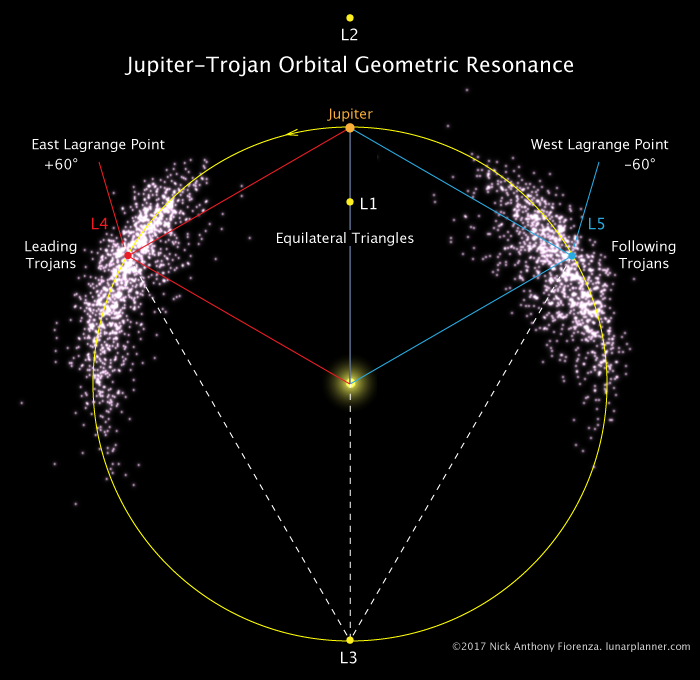Trojan Asteroids
The Trojan asteroids are a large group of objects that share the orbit of the planet Jupiter around the Sun. Viewed from a coordinate system that is fixed on Jupiter, they appear to orbit one of the two Lagrangian points of stability, L4 and L5, that lie 60° ahead of and behind Jupiter in its orbit.
As originally defined, Trojan asteroids have a semi-major axis between 5.05 AU and 5.40 AU, and lie in elongated, curved regions around the two Lagrangian points. The term is sometimes used to refer to minor bodies with similar relationships to other major bodies, in which case the name of the major body is included, e.g. the Neptunian Trojan 2001 QR322.
All the asteroids at the leading L4 point have names corresponding to participants on the Greek side of the Trojan War, except for 624 Hektor, which was named before this naming convention was instituted. Correspondingly, 617 Patroclus is a Greek-named asteroid at the "Trojan" (L5) Lagrangian point.
In February 1906, the German astronomer Max Wolf discovered an asteroid at the L4 Lagrangian point of the Sun–Jupiter system, and named it 588 Achilles, after the mythical Achilles, one of the heroes of Homer's Iliad. The oddity of its orbit was realized within a few months, and before long, many other asteroids were discovered at this point (and the other triangular Lagrange point of the Sun–Jupiter system).
As of August 2005, the number of known Trojan asteroids is 1108 at L4 and 718 at L5. There are undoubtedly many others too small to be seen with current instruments. (By October 1999, 170 had been numbered; by July 2004, that number had grown to 877.) The largest of the Trojans is 624 Hektor, measuring 370×195 km.
624 Hektor
Hektor is the largest of the Jovian Trojan asteroids. It is a D-type asteroid, dark and reddish in colour, and was discovered in 1907 by August Kopff.
Hektor is one of the most elongated bodies of its size in the solar system, being 370 × 195 km. It is thought that Hektor might be a contact binary (two asteroids joined by gravitational attraction) like 216 Kleopatra. Hubble Space Telescope observations of Hektor in 1993 did not show an obvious bilobated shape, but did not rule out the possibility of a contact binary.
617 Patroclus
Patroclus is a binary minor planet made up of two similarly-sized objects orbiting their common centre of gravity. It is classified as a Trojan, sharing an orbit with Jupiter. It was discovered in 1907 by August Kopff, and was the second Trojan asteroid to be discovered.
A team from the Keck Observatory in Hawaii announced in 2006 that they had measured the density of the binary Trojan asteroid 617 Patroclus as being less than that of water ice, suggesting that the pair, and possibly all the Trojan objects, more closely resemble comets or Kuiper Belt objects in size and composition—water ice with a layer of dust—than they do the main belt asteroids.
| Hektor and Patroclus facts | ||
| Asteroid | 624 Hektor | 617 Patroclus |
| Discoverer | August Kopff | August Kopff |
| Discovery date | 02-10-1907 | 10-17-1906 |
| Category | Trojan asteroid | Jupiter Trojan |
| Eccentricity (e) | 0.024 | 0.138 |
| Semi-major axis (a) | 5.222 AU | 5.228 AU |
| Perihelion (q) | 5.095 AU | 4.506 AU |
| Aphelion (Q) | 5.349 AU | 5.950 AU |
| Orbital period (P) | 4358.521 days | 4365.7 days |
| Mean orbital speed | 13.03 km/s | ??? |
| Inclination (i) | 18.198° | 22.03° |
| Dimensions | 370 × 195 km | 122 km & 112 km |
| Mass | ⁓1.4×1019 kg | 1.36×1018 kg |
| Density | 2 ? g/cm³ | 0.8 g/cm³ |
| Surface gravity | ⁓0.067 m/s² | ??? |
| Escape velocity | ⁓0.13 km/s | ??? |
| Rotation period | 0.2884 days | >4.283 days |
| Spectral class | D | P |
| Absolute magnitude | 7.49 | 8.19 |
| Albedo | 0.087 | 0.047 |
| Mean surface temperature | - | 110 K |
* Of course Hector does not belong to the Greek side in the Iliad nor Patroclus to the Trojan side. This apparent error is due to the fact that both were discovered and named before the names of the fields were agreed. All other asteroid names do correspond to their field

